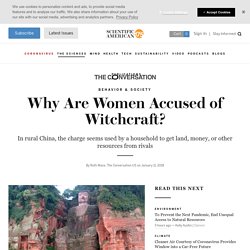The Truth Behind "Witch Hunts"
> Josihicks
Where Witch Hunts Began. When someone cries “witch hunt,” Americans tend to think of 1690s Salem, Massachusetts.

But, as sociologist Nachman Ben-Yehuda explains, the persecution of supposed witches had been going on for a long time before that across continental Europe, resulting in the execution of 200,000 to 500,000 people, most of them women, between the fourteenth and seventeenth centuries. Despite what Monty Python might lead you to believe, according to Ben-Yehuda there’s hardly any record of “witch crazes” in the early Middle Ages. Before the fourteenth century, he argues, many Europeans understood witchcraft as a kind of neutral technology.
When witches used spells or love potions, they were harnessing unseen forces for specific goals, which might be good or bad.
SSRN id3085196. Most witches are women, because witch hunts were all about persecuting the powerless. “Witch hunt” – it’s a refrain used to deride everything from impeachment inquiries and sexual assault investigations to allegations of corruption.

When powerful men cry witch, they’re generally not talking about green-faced women wearing pointy hats. They are, presumably, referring to the Salem witch trials, when 19 people in 17th-century Massachusetts were executed on charges of witchcraft. Using “witch hunt” to decry purportedly baseless allegations, however, reflects a misunderstanding of American history. Witch trials didn’t target the powerful. They persecuted society’s most marginal members – particularly women. Too rich, too poor, too female In my scholarship on the darker aspects of U.S. culture, I’ve researched and written about numerous witch trials.
This Halloween, remember witch hunts were created by a patriarchy terrified of older women. On a summer morning in 1692, Bridget Bishop, who was accused of being a witch, was hanged from an oak tree in Salem, Massachusetts, then dumped into a shallow grave.

The thrice-married Bridget, 60, was decried for possessing dark powers by her stepchildren after her second husband’s death, in what may have been a bid to seize his property. She beat that earlier charge — but during the Salem witch panic, her luck ran out. Out of the 16 falsely accused women of Salem and nearby villages who were either hanged or died in rat-infested dungeons awaiting execution, at least 13 were past their childbearing years, Jackie Rosenhek notes in “Mad with Menopause.”
In patriarchal societies — including our own — post-reproductive women have often been scapegoated as threats and burdens.
5 Notable Women Hanged in the Salem Witch Trials. In early 1692, during the depths of winter in Massachusetts Bay Colony, a group of young girls in the village of Salem began acting strangely.

The daughter and niece of the local minister, Samuel Parris, claimed to be afflicted by invisible forces who bit and pinched them, sending their limbs flailing. By mid-February, two more girls had joined them, and the first waves of panic gripped Salem’s residents: The girls had been bewitched. The afflicted girls soon accused three women: the Parris’ “Indian” slave, Tituba; a local beggar woman, Sarah Good; and an invalid widow, Sarah Osbourne. As local magistrates began questioning the accused, people packed into a tavern to witness the girls come face to face with the women they had accused of witchcraft. While the other two women denied the accusations against them, Tituba told vivid stories of how Satan had revealed himself to her. 1. Ten witnesses testified against Bishop, and she was quickly found guilty and sentenced to death. 2. 3. 4. 5.
Tituba. What really happened during the Salem Witch Trials - Brian A. Pavlac.
Women Weren’t the Only Victims of the Salem Witch Trials. John Proctor sat in the courtroom, watching his pregnant wife, Elizabeth on the stand.

Paranoia was sweeping Salem, and Elizabeth was being examined by a local judge on suspicion of witchcraft. Watching his wife withstand the heated examination was bad enough, but suddenly the tenor of the questions changed. Slowly, John realized that the questions the judge fired at his wife were more about his behavior than hers. Proctor had spoken out vehemently against the trials—he thought the accusers were liars and had even beaten one of his servants for displaying what the town interpreted as signs of witchcraft. It was just a matter of time before the 60-year-old merchant found himself in the crosshairs of Salem’s paranoia.
From Circe to Clinton: why powerful women are cast as witches. During the 2016 US presidential election, American social media was flooded with images of Hillary Clinton wearing a black hat and riding a broom, or else cackling with green skin.

The modern day witch hunt by rachelenius d1uzruo fullview. Why Are Women Accused of Witchcraft?
The following essay is reprinted with permission from The Conversation, an online publication covering the latest research.

From medieval witch hunts in Europe to contemporary “witch doctors” in Tanzania, belief in witchcraft has existed across human societies throughout history. Anthropologists have long been fascinated by the phenomenon, but have struggled to study it with quantitative methods—our understanding of how and why it arises is therefore poor. But a study we conducted of one Chinese region provided an opportunity to test the most common hypothesis—that witchcraft accusations act as punishment for those who do not cooperate with local norms.
According to this theory, witch tags mark supposedly untrustworthy individuals and encourage others to conform out of fear of being labelled.
Nigeria witch. Witch Hunts Today: Abuse of Women, Superstition and Murder Collide in India. Men circled the three women, their fists wrapped around thick iron pipes and wooden sticks.

The women huddled on the ground at the center of their village in the western Indian state of Gujarat and whimpered as the crowd gathered. Two young men had died in the village, and the women were being called dakan, the Gujarati word for witch. They were accused of feasting on the young men’s souls.
Ghana witch camp slah.








